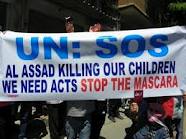 Most of the 108 people killed in the Syrian town of Houla were civilians, nearly half of them children, and entire families were shot dead in their homes, the U.N. human rights office said on Tuesday.
Most of the 108 people killed in the Syrian town of Houla were civilians, nearly half of them children, and entire families were shot dead in their homes, the U.N. human rights office said on Tuesday.
Witnesses and survivors have told U.N. investigators that most victims died in two bouts of summary executions carried out by “shabbiha “ or “Shabbeeha” militiamen loyal to President Bashar al-Assad in the nearby village of Taldaou last Friday, U.N. rights spokesman Rupert Colville said.
Fewer than 20 of the 108 deaths can be blamed on artillery and tank fire, according to preliminary information, he added.
“What is very clear is that this was an absolutely abominable event that took place in Houla, and at least a substantial part of it were summary executions of civilians – women and children,” Colville said.
“At this point it looks like entire families were shot in their houses,” he said.
Some 49 children and 34 women were among the known victims, but the toll was not definitive, Colville said, adding: “There are reports of more deaths.”
“Almost half of the ones we know of so far are children – that is totally unpardonable – and a very large number of women as well,” he said.
FAMILIES SHOT IN THEIR HOUSES
Some witnesses indicated that the Shabbiha came from the surrounding area, but more investigation is needed, Colville said. The information came from U.N. investigators at the site as well as other sources whom he declined to identify.
The Syrian government has blamed Islamist militants for the killings in Houla.
U.N. peacekeeping chief Herve Ladsous said on Tuesday that the army and militia supporting Assad were probably responsible for the killings with small arms and knives.
“Part of the victims had been killed by artillery shells, now that points ever so clearly to the responsibility of the government. Only the government has heavy weapons, has tanks, has howitzers,” Ladsous told reporters in New York.
“But there are also victims from individual weapons, victims from knife wounds and that of course is less clear but probably points the way to the (pro-Assad) shabbihas, the local militia,” he said.
Initially, when U.N. investigators reported a total of 85 bodies photographed in a morgue on Saturday, they included 32 children under the age of 10, according to Colville. He did not know the ages of all 49 children now known to have been killed.
Separate U.N. rights investigators led by Brazilian expert Paulo Pinheiro, had said in a report just days before the Houla killings, that government forces executed entire families in their homes – often entering a town with a list of wanted.
Karen AbuZayd, the senior American investigator with Pinheiro, said that their team of about 15 experts may try to probe the Houla killings as part of their next report.
“We are discussing with UNSMIS over the next days to see whether we can also have a look and maybe corroborate with information we get from outside the country,” AbuZayd told Reuters on Tuesday, speaking from a neighboring country where she is interviewing Syrian refugees who have fled the conflict.
Referring to the Houla massacre, she said: “This is certainly something new and that is why the perpetrators need to be further investigated before blame is assigned.
The latest report by Pinheiro and AbuZayd, based on more than 200 interviews, also said that rebels had tortured and killed soldiers and government supporters.
Western powers expelled Syria’s envoys on Tuesday in outrage at the Houla killings.
Syria has never allowed the U.N.-backed commission of inquiry led by Pinheiro into the country to investigate. Colville urged the government on Tuesday to grant them “immediate and unfettered access to the country”.
“It is extremely important that we get to the bottom of exactly what happened,” he said. “When you have this kind of crime, ideally you would have forensic investigations. In current circumstances it’s obviously not going to be that easy”.
Reuters
Leave a Reply
You must be logged in to post a comment.